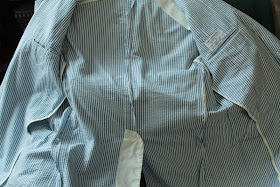Only recently, at the end of last year, did I discover that I needn't to wear glasses. After one too many times driving home at night afraid I might hit a tree, I learned that all this time spent in front of various screens was making it difficult for me to focus at night (the things I do for you, dear readers). In any case, eyewear now became an accessory to consider, one I hadn't given any thought to in the past.
I also hadn't given any thought to the fact that good glasses are apparently unbelievably expensive.Seriously, what a racket. It was the end of December, and we had some flexible spending insurance money to use up, and Mrs. G already has five pair of glasses, so I was in luck. My first glasses were a pair similar to the ones above, but by Burberry. The full price of those was over four hundred dollars (!?!?!). Fortunately, between insurance, sales at the optometrist, and the flexible spending money that wasn't going to carry over into the new year, I managed to get the price down to about $125. I like those glasses, and still wear them 50% off the time. Trouble is they're black, and I really wanted a brown tortoiseshell pair to work with other outfits. Black frames can be a little too harsh, especially when wearing round lenses.
I had heard good things about Warby Parker, who offer a full pair of prescription glasses for $95. I had them send me five pair of frames for home try on, which was a great service. The frames were of good quality and looked well, so after deciding on a pair, I sent back the samples and ordered some. I was disappointed to discover that Warby Parker could not make my lenses, which require prism correction.
Enter Zenni Optical. A good friend at work who is literally blind without his glasses told me about them, saying that many glasses were as cheap as forty or fifty dollars. It sounded unbelievable, but this is a guy who depends on his glasses, so I took his word as a sound endorsement. I ordered the pair above, which came to $42.99 shipped. I figured if they were crappy I could at least leave them on the bedside table and use them around the house. Two weeks later they arrived, in a cheap case in a padded envelope. But the glasses themselves are more than acceptable. The frame is sturdy, the prescription is correct, they look cool, and if I loose them or break them it won't kill me to just get another pair. Best of all, no visible brand name on them, unlike the status seking Burberry pair. At prices like that, there's no reason not to keep a selection of glasses for various purposes. I'll be back to buy more soon.
Zenni Optical is worth every penny, even if it isn't so many pennies.



.JPG)
.JPG)
.JPG)


















